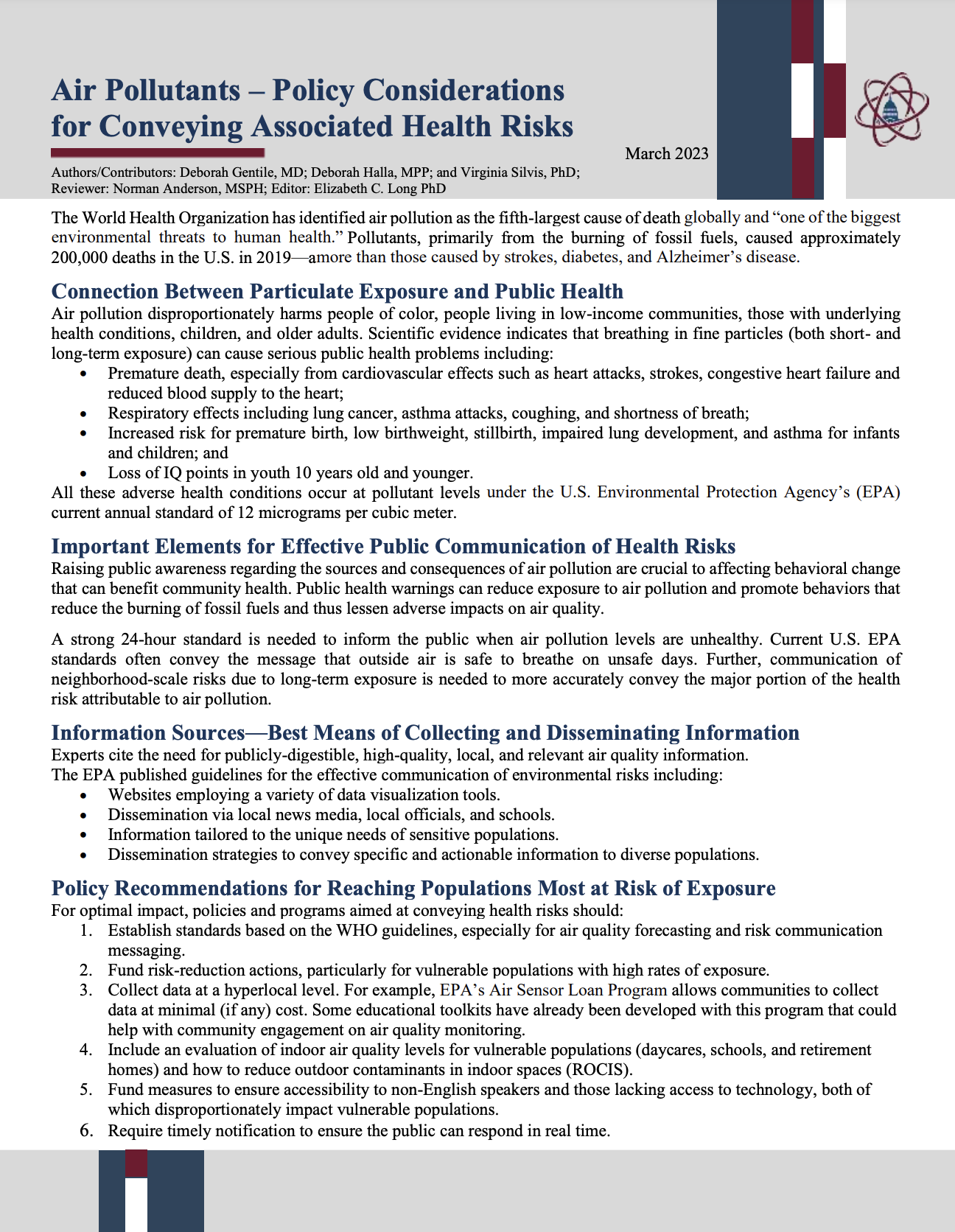
The World Health Organization has identified air pollution as the fifth-largest cause of death globally and “one of the biggest environmental threats to human health.” Pollutants, primarily from the burning of fossil fuels, caused approximately 200,000 deaths in the U.S. in 2019–more than those caused by strokes, diabetes, and Alzheimer’s disease.
Connection Between Particulate Exposure and Public Health
Air pollution disproportionately harms people of color, people living in low-income communities, those with underlying health conditions, children, and older adults. Scientific evidence indicates that breathing fine particles (both short- and long-term exposure) can cause serious public health problems including:
- Premature death, especially from cardiovascular effects such as heart attacks, strokes, congestive heart failure and reduced blood supply to the heart;
- Respiratory effects including lung cancer, asthma attacks, coughing, and shortness of breath;
- Increased risk for premature birth, low birthweight, stillbirth, impaired lung development, and asthma for infants and children; and
- Loss of IQ points in youth 10 years old and younger.
All these adverse health conditions occur at pollutant levels under the U.S. Environmental Protection Agency’s (EPA) current annual standard of 12 micrograms per cubic meter.
Important Elements For Effective Public Communications Of Health Risks
Raising public awareness regarding the sources and consequences of air pollution are crucial to affecting behavioral change that can benefit community health. Public health warnings can reduce exposure to air pollution and promote behaviors that reduce the burning of fossil fuels and thus lessen adverse impacts on air quality.
A strong 24-hour standard is needed to inform the public when air pollution levels are unhealthy. Current U.S. EPA standards often convey the message that outside air is safe to breathe on unsafe days. Further, communication of neighborhood-scale risks due to long-term exposure is needed to more accurately convey the major portion of the health risk attributable to air pollution.
Information Sources–Best Means Of Collecting And Disseminating Information
Experts cite the need for publicly-digestible, high-quality, local, and relevant air quality information.
The EPA published guidelines for the effective communication of environmental risks including:
- Websites employing a variety of data visualization tools.
- Dissemination via local news media, local officials, and schools.
- Information tailored to the unique needs of sensitive populations.
- Dissemination strategies to convey specific and actionable information to diverse populations.
Policy Recommendations For Reaching Populations Most At Risk Of Exposure
For optimal impact, policies and programs aimed at conveying health risks should:
- Establish standards based on the WHO guidelines, especially for air quality forecasting and risk communication messaging.
- Fund risk-reduction actions, particularly for vulnerable populations with high rates of exposure.
- Collect data at a hyperlocal level. For example, EPA’s Air Sensor Loan Program allows communities to collect data at minimal (if any) cost. Some educational toolkits have already been developed with this program that could help with community engagement on air quality monitoring.
- Include evaluation of indoor air quality levels for vulnerable populations (daycares, schools, and retirement homes) and how to reduce outdoor contaminants in indoor spaces (ROCIS).
- Fund measures to ensure accessibility to non-English speakers and those lacking access to technology, both of which disproportionately impact vulnerable populations.
- Require timely notification to ensure the public can respond in real time.
The Research-to-Policy Collaboration (RPC) works to bring together research professionals and public officials to support evidence-based policy. Please visit their website to learn more.
Key Information
RPC Website
Research-to-Policy Collaboration
Publication DateMarch 22, 2023
Topic Area(s)Health, Environment and Earth Sciences
Resource TypeWritten Briefs
Share This Page
The World Health Organization has identified air pollution as the fifth-largest cause of death globally and “one of the biggest environmental threats to human health.” Pollutants, primarily from the burning of fossil fuels, caused approximately 200,000 deaths in the U.S. in 2019–more than those caused by strokes, diabetes, and Alzheimer’s disease.
Connection Between Particulate Exposure and Public Health
Air pollution disproportionately harms people of color, people living in low-income communities, those with underlying health conditions, children, and older adults. Scientific evidence indicates that breathing fine particles (both short- and long-term exposure) can cause serious public health problems including:
- Premature death, especially from cardiovascular effects such as heart attacks, strokes, congestive heart failure and reduced blood supply to the heart;
- Respiratory effects including lung cancer, asthma attacks, coughing, and shortness of breath;
- Increased risk for premature birth, low birthweight, stillbirth, impaired lung development, and asthma for infants and children; and
- Loss of IQ points in youth 10 years old and younger.
All these adverse health conditions occur at pollutant levels under the U.S. Environmental Protection Agency’s (EPA) current annual standard of 12 micrograms per cubic meter.
Important Elements For Effective Public Communications Of Health Risks
Raising public awareness regarding the sources and consequences of air pollution are crucial to affecting behavioral change that can benefit community health. Public health warnings can reduce exposure to air pollution and promote behaviors that reduce the burning of fossil fuels and thus lessen adverse impacts on air quality.
A strong 24-hour standard is needed to inform the public when air pollution levels are unhealthy. Current U.S. EPA standards often convey the message that outside air is safe to breathe on unsafe days. Further, communication of neighborhood-scale risks due to long-term exposure is needed to more accurately convey the major portion of the health risk attributable to air pollution.
Information Sources–Best Means Of Collecting And Disseminating Information
Experts cite the need for publicly-digestible, high-quality, local, and relevant air quality information.
The EPA published guidelines for the effective communication of environmental risks including:
- Websites employing a variety of data visualization tools.
- Dissemination via local news media, local officials, and schools.
- Information tailored to the unique needs of sensitive populations.
- Dissemination strategies to convey specific and actionable information to diverse populations.
Policy Recommendations For Reaching Populations Most At Risk Of Exposure
For optimal impact, policies and programs aimed at conveying health risks should:
- Establish standards based on the WHO guidelines, especially for air quality forecasting and risk communication messaging.
- Fund risk-reduction actions, particularly for vulnerable populations with high rates of exposure.
- Collect data at a hyperlocal level. For example, EPA’s Air Sensor Loan Program allows communities to collect data at minimal (if any) cost. Some educational toolkits have already been developed with this program that could help with community engagement on air quality monitoring.
- Include evaluation of indoor air quality levels for vulnerable populations (daycares, schools, and retirement homes) and how to reduce outdoor contaminants in indoor spaces (ROCIS).
- Fund measures to ensure accessibility to non-English speakers and those lacking access to technology, both of which disproportionately impact vulnerable populations.
- Require timely notification to ensure the public can respond in real time.
The Research-to-Policy Collaboration (RPC) works to bring together research professionals and public officials to support evidence-based policy. Please visit their website to learn more.

Key Information
RPC Website
Research-to-Policy Collaboration
Publication DateMarch 22, 2023
Topic Area(s)Health, Environment and Earth Sciences
Resource TypeWritten Briefs
Share This Page
LET’S STAY IN TOUCH
Join the Evidence-to-Impact Mailing List
Keep up to date with the latest resources, events, and news from the EIC.




